All-Optically Controlled Terahertz Modulation by Silicon-Grown CdSe/CdZnS Colloidal Quantum Wells
Abstract
1. Introduction
2. Characterization of Sample and Experiment Setup
3. Result and Discussion
3.1. Characterization of CdSe/CdZnS Core/Shell
3.2. Terahertz Transmission Results
4. Conclusions
Author Contributions
Funding
Data Availability Statement
Acknowledgments
Conflicts of Interest
References
- Zhu, M.; Zhang, J.; Hua, B.; Lei, M.; Cai, Y.; Tian, L.; Wang, D.; Xu, W.; Zhang, C.; Huang, Y.; et al. Ultra-wideband fiber-THz-fiber seamless integration communication system toward 6G: Architecture, key techniques, and testbed implementation. Sci. China Inf. Sci. 2022, 66, 1–18. [Google Scholar] [CrossRef]
- Li, X.J.; Wang, D.; Gong, J.W. Research progress of photonics-assisted terahertz communications. Chin. J. Quantum Electron. 2023, 40, 423–435. [Google Scholar] [CrossRef]
- Park, D.W.; Bin Ji, Y.; Choi, I.; Hwang, J.; Shin, J.C.; Cho, J.C.; Lee, E.S.; Oh, S.J.; Noh, S.; Shin, J.; et al. Terahertz biomedical imaging using a terahertz emitter based on InAs nanowires. Nanoscale 2025, 17, 7211–7217. [Google Scholar] [CrossRef]
- Takida, Y.; Nawata, K.; Minamide, H. Security screening system based on terahertz-wave spectroscopic gas detection. Opt. Express 2021, 29, 2529–2537. [Google Scholar] [CrossRef]
- Kissinger, D.; Kahmen, G.; Weigel, R. Millimeter-Wave and Terahertz Transceivers in SiGe BiCMOS Technologies. IEEE Trans. Microw. Theory Tech. 2021, 69, 4541–4560. [Google Scholar] [CrossRef]
- Galiffi, E.; Pendry, J.B.; Huidobro, P.A. Broadband Tunable THz Absorption with Singular Graphene Metasurfaces. ACS Nano 2018, 12, 1006–1013. [Google Scholar] [CrossRef]
- Tang, W.; Politano, A.; Guo, C.; Guo, W.; Liu, C.; Wang, L.; Chen, X.; Lu, W. Ultrasensitive Room-Temperature Terahertz Direct Detection Based on a Bismuth Selenide Topological Insulator. Adv. Funct. Mater. 2018, 28, 1801786. [Google Scholar] [CrossRef]
- Ghosh, S.; Bhattacharya, K.; Sasmal, S.; Bhatt, K.; Kandar, S.; Khan, B.; Luo, C.; Singh, R.; Basu, A.; Das, S. Optically Pumped Ultrafast and Broadband Terahertz Modulation with Scalable Molecular Beam Epitaxy Grown MoTe2/Si Heterostructures. Adv. Mater. Technol. 2025, 10, 2402036. [Google Scholar] [CrossRef]
- Song, C.H.; Sun, S.; Jin, K. Progress on terahertz time-domain spectrum technology in the field of materials science. J. Cap. Norm. Univ. (Nat. Sci. Ed.) 2024, 45, 14–26. [Google Scholar] [CrossRef]
- Chang, Q.; Cheng, S.J.; Wang, Y.S. New Progress of Terahertz Spectroscopy in Characterization of Halide Perovskite Materials. Laser Optoelectron. Prog. 2025, 62, 0100008. [Google Scholar]
- Pickwell, E.; Wallace, V.P. Biomedical applications of terahertz technology. J. Phys. D Appl. Phys. 2006, 39, R301–R310. [Google Scholar] [CrossRef]
- Qiao, J.; Wang, S.; Wang, Z.; He, C.; Zhao, S.; Xiong, X.; Wang, S.; Zhang, X.; Tao, X. Ultrasensitive and Broadband All-Optically Controlled THz Modulator Based on MoTe2/Si van der Waals Heterostructure. Adv. Opt. Mater. 2020, 8, 2000160. [Google Scholar] [CrossRef]
- Zhang, P.; Liang, Q.; Zhou, Q.; Chen, J.; Li, M.; Deng, Y.; Liang, W.; Zhang, L.; Zhang, Q.; Gu, L.; et al. High-performance terahertz modulators induced by substrate field in Te-based all-2D heterojunctions. Light. Sci. Appl. 2024, 13, 1–10. [Google Scholar] [CrossRef]
- Cong, L.; Srivastava, Y.K.; Zhang, H.; Zhang, X.; Han, J.; Singh, R. All-optical active THz metasurfaces for ultrafast polarization switching and dynamic beam splitting. Light. Sci. Appl. 2018, 7, 1–9. [Google Scholar] [CrossRef]
- Kim, M.; Kim, S.-H.; Kang, C.; Kim, S.; Kee, C.-S. Highly efficient graphene terahertz modulator with tunable electromagnetically induced transparency-like transmission. Sci. Rep. 2023, 13, 1–7. [Google Scholar] [CrossRef]
- Zhou, M.; Li, A.; Li, S.; Zhang, F.; Li, Z.; Jin, B. All-optical broadband terahertz modulator based on NiO/Si heterojunction and interface photoconductivity analysis. APL Mater. 2025, 13, 031119. [Google Scholar] [CrossRef]
- Li, S.; Zhang, F.; Han, Q.; Zhou, M.; Yan, L.; Tan, Y.; Li, X.; Li, A.; Abulimiti, B.; Li, Z.; et al. All-optical broadband terahertz modulator based on CdS NWs/Si heterojunction and interface photoconductivity analysis. Phys. Scr. 2024, 99, 115516. [Google Scholar] [CrossRef]
- Wang, C.; Zhao, H.; Zhao, X.; Sun, B.; Lian, J.; Gao, Y. Layer-dependent optical and dielectric properties of CdSe semiconductor colloidal quantum wells characterized by spectroscopic ellipsometry. J. Semicond. 2025, 46, 042102. [Google Scholar] [CrossRef]
- Hu, Z.; Singh, A.; Goupalov, S.V.; Hollingsworth, J.A.; Htoon, H. Influence of morphology on the blinking mechanisms and the excitonic fine structure of single colloidal nanoplatelets. Nanoscale 2018, 10, 22861–22870. [Google Scholar] [CrossRef]
- Shornikova, E.V.; Biadala, L.; Yakovlev, D.R.; Sapega, V.F.; Kusrayev, Y.G.; Mitioglu, A.A.; Ballottin, M.V.; Christianen, P.C.M.; Belykh, V.V.; Kochiev, M.V.; et al. Addressing the exciton fine structure in colloidal nanocrystals: The case of CdSe nanoplatelets. Nanoscale 2017, 10, 646–656. [Google Scholar] [CrossRef] [PubMed]
- Geuchies, J.J.; Dijkhuizen, R.; Koel, M.; Grimaldi, G.; du Fossé, I.; Evers, W.H.; Hens, Z.; Houtepen, A.J. Zero-Threshold Optical Gain in Electrochemically Doped Nanoplatelets and the Physics Behind It. ACS Nano 2022, 16, 18777–18788. [Google Scholar] [CrossRef]
- Dikmen, Z.; Işık, A.T.; Bozkaya, I.; Baruj, H.D.; Canımkurbey, B.; Shabani, F.; Ahmad, M.; Demir, H.V. Vertically oriented self-assembly of colloidal CdSe/CdZnS quantum wells controlled via hydrophilicity/lipophilicity balance: Optical gain of quantum well stacks for amplified spontaneous emission and random lasing. Nanoscale 2023, 15, 9745–9751. [Google Scholar] [CrossRef] [PubMed]
- Olutas, M.; Guzelturk, B.; Kelestemur, Y.; Yeltik, A.; Delikanli, S.; Demir, H.V. Lateral Size-Dependent Spontaneous and Stimulated Emission Properties in Colloidal CdSe Nanoplatelets. ACS Nano 2015, 9, 5041–5050. [Google Scholar] [CrossRef] [PubMed]
- Wang, C.; Zhao, H.; Zhao, X.; Sun, B.; Gao, Y. Speckle-free laser display enabled by self-assembled supraparticles of semiconductor nanoplatelets. Nano Res. 2025, 18, 94907170. [Google Scholar] [CrossRef]
- Li, Y.; Wang, L.; Wang, J.; Zhu, J.; Wu, K. Autler-Townes splitting and linear dichroism in colloidal CdSe nanoplatelets driven by near-infrared pulses. Sci. Adv. 2024, 10, eabq2729. [Google Scholar] [CrossRef]
- Wen, Q.; He, Y.; Yang, Q.; Yu, P.; Feng, Z.; Tan, W.; Wen, T.; Zhang, Y.; Chen, Z.; Zhang, H. High-Performance Photo-Induced Spatial Terahertz Modulator Based on Micropyramid Silicon Array. Adv. Mater. Technol. 2020, 5, 1901058. [Google Scholar] [CrossRef]
- Steenbock, T.; Drescher, E.; Dittmann, T.; Bester, G. How Surface Defects Shape the Excitons and Photoluminescence of Ultrasmall CdSe Quantum Dots. Chem. Mater. 2024, 36, 6504–6514. [Google Scholar] [CrossRef]
- Jakhar, A.; Kumar, P.; Husain, S.; Dhyani, V.; Das, S. Integration of Nanometer-Thick 1T-TaS2 Films with Silicon for an Optically Driven Wide-Band Terahertz Modulator. ACS Appl. Nano Mater. 2020, 3, 10767–10777. [Google Scholar] [CrossRef]


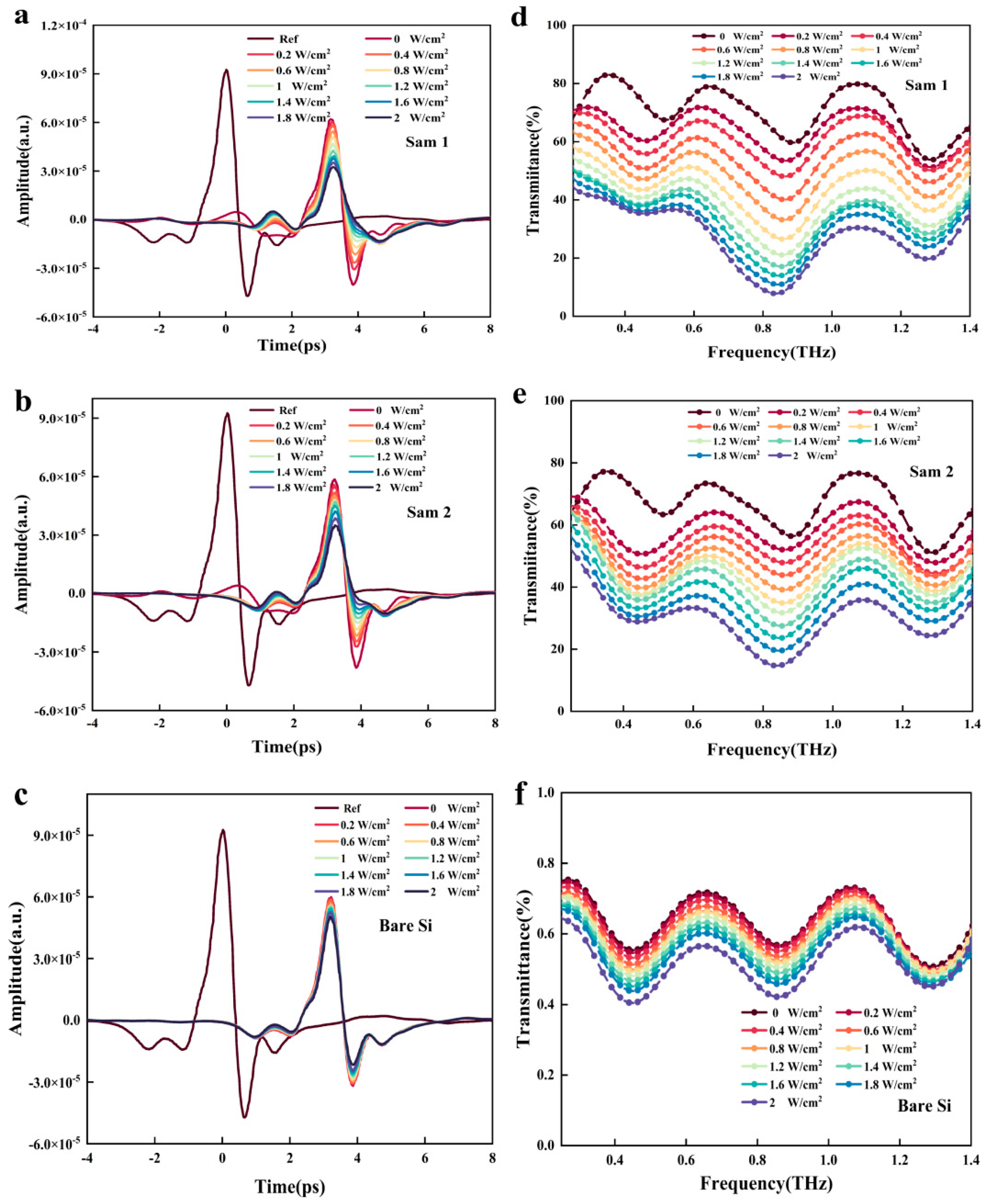
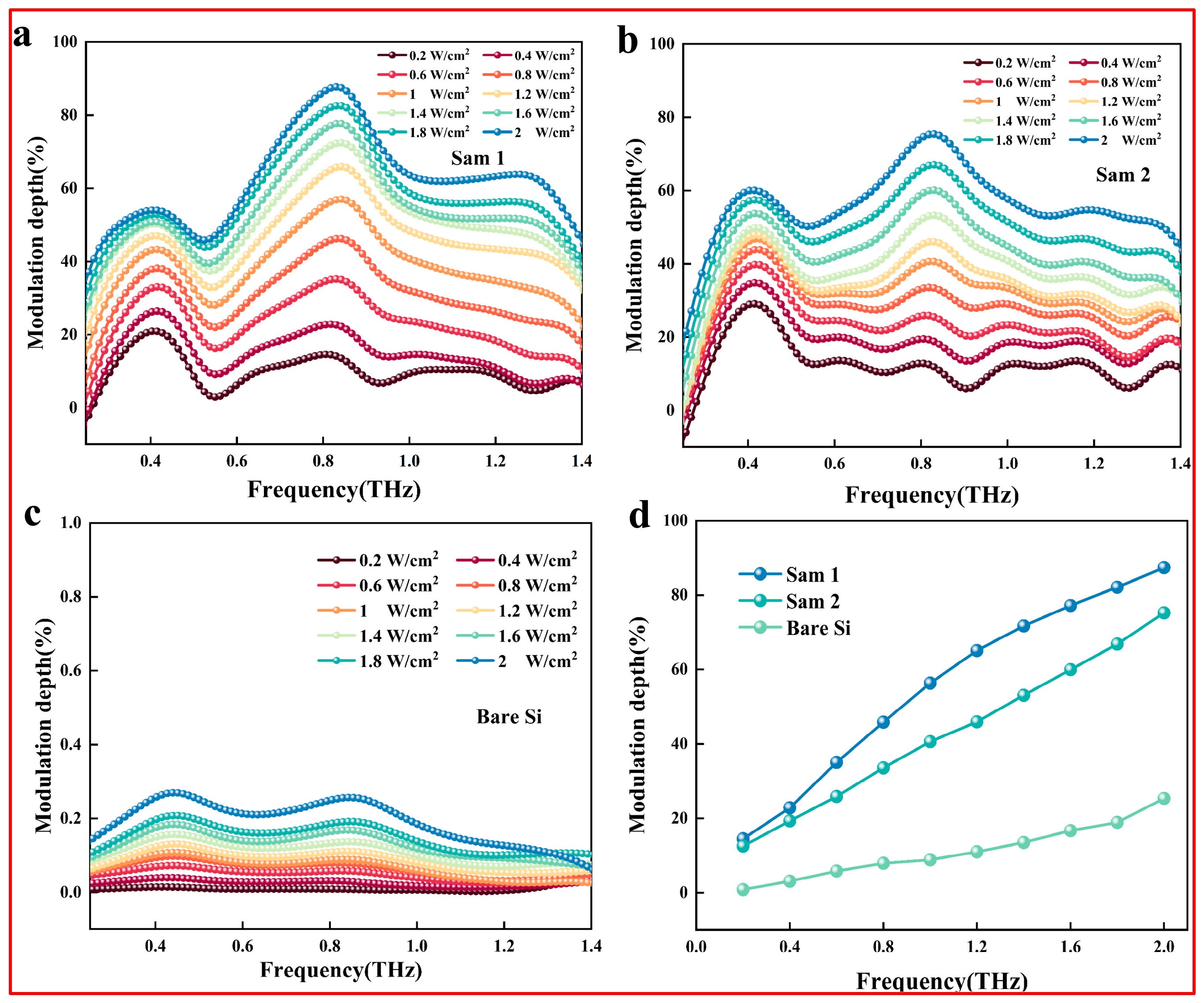
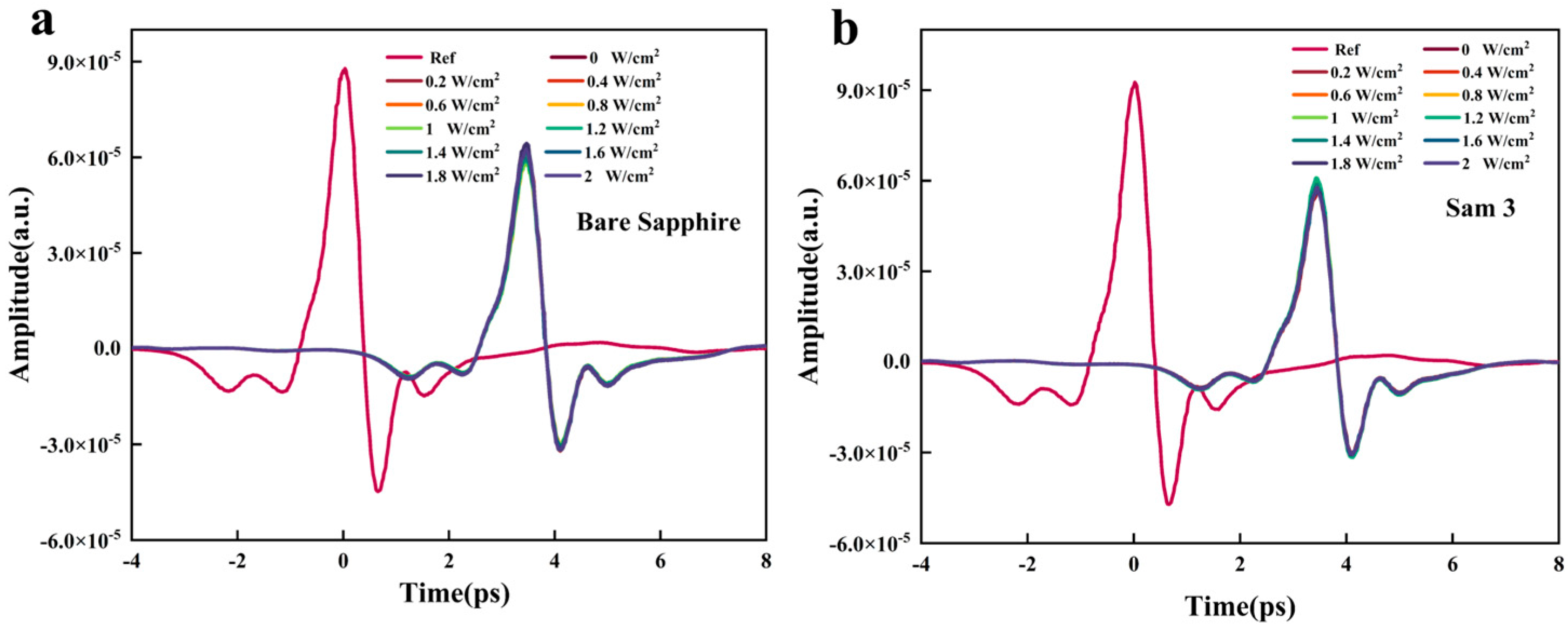
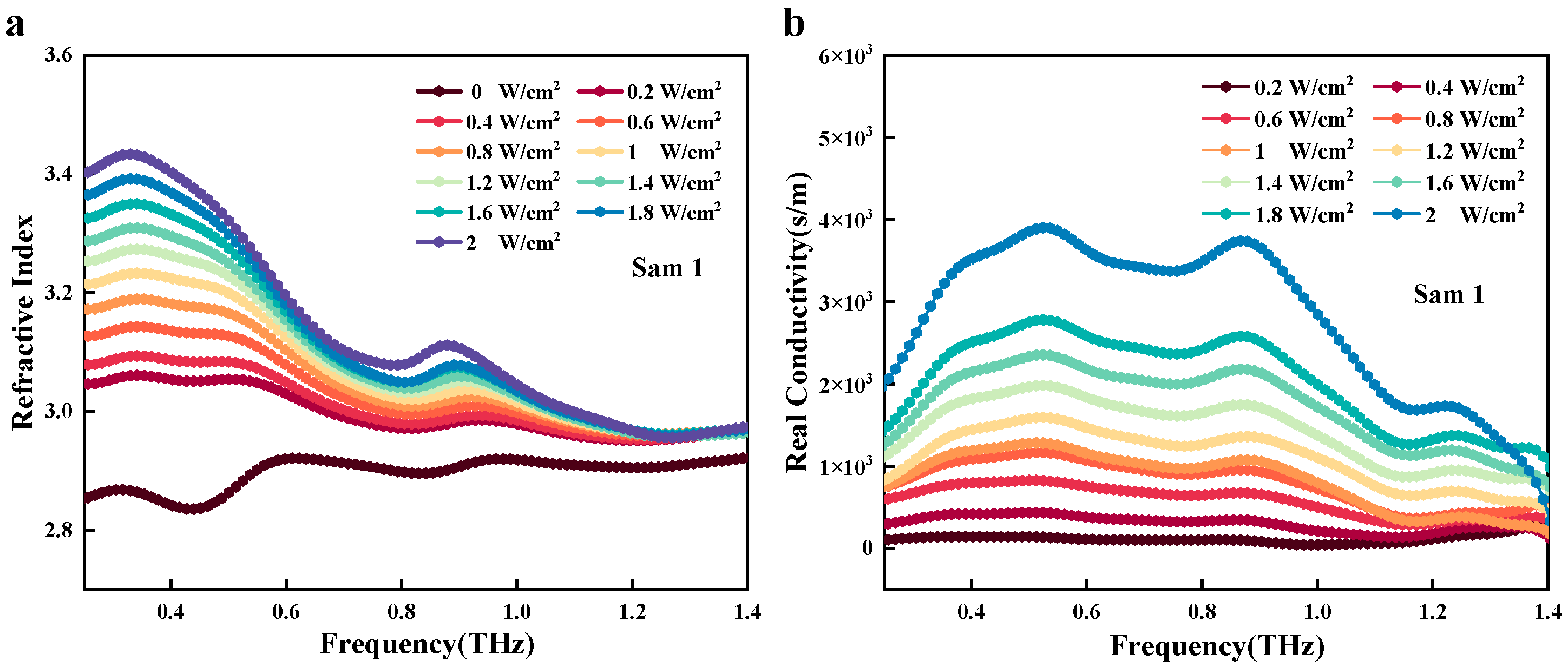
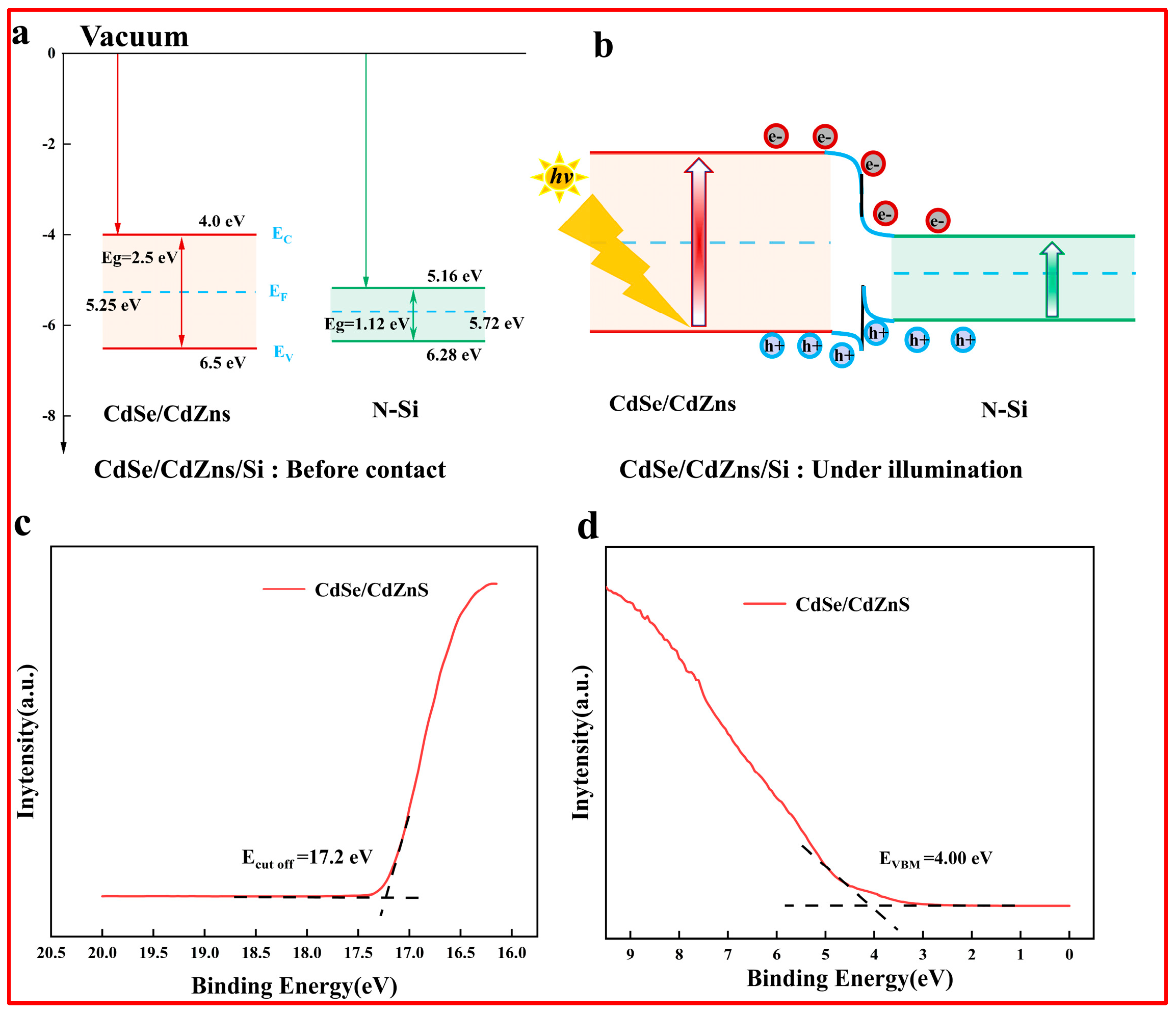
| E | CdSe/CdZnS | Si |
|---|---|---|
| ECB | 6.5 eV | 6.28 eV |
| EVB | 4.0 eV | 5.16 eV |
| Eg | 2.5 eV | 1.12 eV |
| EF | 5.25 eV | 5.72 eV |
Disclaimer/Publisher’s Note: The statements, opinions and data contained in all publications are solely those of the individual author(s) and contributor(s) and not of MDPI and/or the editor(s). MDPI and/or the editor(s) disclaim responsibility for any injury to people or property resulting from any ideas, methods, instructions or products referred to in the content. |
© 2025 by the authors. Licensee MDPI, Basel, Switzerland. This article is an open access article distributed under the terms and conditions of the Creative Commons Attribution (CC BY) license (https://creativecommons.org/licenses/by/4.0/).
Share and Cite
Tudi, R.; Zhang, Z.; Song, X.; AbulimitiYasen; Abulimiti, B.; Xiang, M. All-Optically Controlled Terahertz Modulation by Silicon-Grown CdSe/CdZnS Colloidal Quantum Wells. Nanomaterials 2025, 15, 1597. https://doi.org/10.3390/nano15201597
Tudi R, Zhang Z, Song X, AbulimitiYasen, Abulimiti B, Xiang M. All-Optically Controlled Terahertz Modulation by Silicon-Grown CdSe/CdZnS Colloidal Quantum Wells. Nanomaterials. 2025; 15(20):1597. https://doi.org/10.3390/nano15201597
Chicago/Turabian StyleTudi, Reyihanguli, Zhongxin Zhang, Xintian Song, AbulimitiYasen, Bumaliya Abulimiti, and Mei Xiang. 2025. "All-Optically Controlled Terahertz Modulation by Silicon-Grown CdSe/CdZnS Colloidal Quantum Wells" Nanomaterials 15, no. 20: 1597. https://doi.org/10.3390/nano15201597
APA StyleTudi, R., Zhang, Z., Song, X., AbulimitiYasen, Abulimiti, B., & Xiang, M. (2025). All-Optically Controlled Terahertz Modulation by Silicon-Grown CdSe/CdZnS Colloidal Quantum Wells. Nanomaterials, 15(20), 1597. https://doi.org/10.3390/nano15201597







